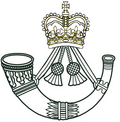| 1st Battalion, The Rifles | |
|---|---|
  Cap and Back badges of The Rifles | |
| Active | 1 February 2007 – |
| Country | |
| Branch | |
| Type | Light Infantry |
| Size | Battalion |
| Part of | 7th Light Mechanised Brigade Combat Team |
| Garrison/HQ | Beachley Barracks, Chepstow |
| Motto(s) | Swift and Bold |
| Colours | Rifle Green |
| March | Quick: Mechanised Infantry Double Past: Keel Row/Road to the Isles Slow: Old Salamanca |
| Commanders | |
| Colonel Commandant | General Sir Nicholas Parker KCB CBE |
| Insignia | |
| Tactical Recognition Flash |  |
| Arm Badge | Croix de Guerre From Devonshire and Dorset Light Infantry |
| Abbreviation | 1 RIFLES |
1st Battalion, The Rifles (1 RIFLES) is a light infantry battalion of The Rifles under the command of 7th Light Mechanised Brigade Combat Team. [1] [2]
